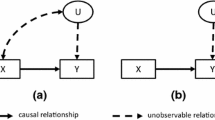Abstract
Studies of school effectiveness often use measures of association, such as regression weights and correlation coefficients. These statistics are used to estimate the size of the change or “effect” that would occur in one variable (for example reading ability) given a particular change in another variable (for example sex and sex ratio). In this paper we explore the limitations of regression coefficients for use in a contextual analysis, in which both individual and contextual variables are included as independent variables. In our example “individual sex” and a context variable “sex ratio of the schoolclass” are regressors, and reading ability is the dependent variable. Our conclusion is that researchers should be careful making interpretations of effects from multiple regression analysis, when dealing with aggregate data. Even in the case (as in our example) when individual and contextual variables are made orthogonal to avoid multicollinearity, interpretation of the effects of the aggregate variable is problematical.
Similar content being viewed by others
References
AitkinM. & LongfordN. (1986) “Statistical modelling issues in school effectiveness studies”, Journal of the Royal Statistical Society 149 (part 1): 1–43.
BoydL.H. & IversenG.R. (1979) Contextual Analysis: Concepts and Statistical Techniques. Belmont: Wadsworth.
Burstein, L. (1980). “The role of levels of analysis in the specification of educational effects”, pp. 116–190, Dreeben, R. & Thomas, J.A. (eds) Analysis of Educational Productivity, Vol. 1. Issues in Micro-Analysis.
CliffN. (1983). “Some cautions concerning the application of causal modelling methods”, Multivariate Behavioral Research 18: 115–128.
ColemanJ.S., CampbellE.Q., HobsonC.F., McPharlandJ., MoodA.M., WeifeldF.D. & YorkR.L. (1966). Equality of Educational Opportunity, Washington D.C.: U.S. Department of Education and Welfare.
CronbachL.J. & WebbN. (1975). “Between class and within class effects in a reported aptitude x treatment interaction: Reanalysis of a study by G.L. Anderson”, Journal of Educational Psychology 67: 717–724.
DeLeeuwJ. & KreftG.G. (1986). “Random coefficient models for multilevel analysis”, Journal of Educational Statistics 11: 1, 57–85.
EfronB. (1979): “Bootstrap methods: Another look at the jackknife”, Annals of Statistics 7: 1–26.
HarnqvistK. (1978). “Primary mental ablities at collective and individual levels”, Journal of Educational Psychology, 70: 706–716.
HoxJ.J. & DeLeeuwE.D. (1986). “De invloed van individuele en contextuele kenmerken op schoolbeleving en leerprestatie”, J.C.Van derWolf & J.J.Hox (eds), Kwaliteit van Onderwijs in Het Geding. Lisse: Swets and Zeitlinger.
JencksC. (1973). Inequality, a Reassessment of the Effect of Family and Schooling in America. New York: Basic Books.
LazarsfeldP.F. (1959). “Problems in methodology”, R.K.Merton, L.Broom & L.S.Cottrell (eds.), Sociology Today, New York: Basic Books.
LazarsfeldP.F. & MenzelH. (1961). “On the relation between indicidual and collective properties”, A.Etzioni (ed.), Complex Organizations. New York. Holt, Rinehart and Winston.
MasonW.M., WongG.Y. & EntwistleB. (1983). “Contextual analysis through the multilevel linear model”, S.Leinhardt (ed.), Sociological Methodology 1983. San Francisco: Jossey Bass.
MayeskeG.W., OkadaT. & BeatonA.E.jr. (1973). A Study of Attitude Toward Life of our Nation's Students. Washington D.C.: Government Printing Office.
MostellerF. & MoynihanD.P. (1972). On Equality of Educational Opportunity. New York: Vintage Books.
MostellerF. & TukeyJ.W. (1968). “Data analysis, including statistics”, G.Lindzey & E.Aronson (eds), Handbook of Social Psychology, Vol. 2. Reading: Addison-Wesley.
OosthoekH. & Van derEedenP., (eds), (1984) Education from the Multilevel Perspective: Models, Methodology, and Empirical Findings. New York: Gordon and Breach.
RobinsonW.S. (1950) “Ecological correlations and the behavior of individuals”, American Sociological Review 15: 351–357.
Van denEedenP. & HuttnerH. J. M. (1982). Multilevel Research, Beverly Hills: Sage.
Author information
Authors and Affiliations
Rights and permissions
About this article
Cite this article
Kreft, G.G., de Leeuw, E.D. The See-Saw Effect: a multilevel problem?. Qual Quant 22, 127–137 (1988). https://doi.org/10.1007/BF00223037
Issue Date:
DOI: https://doi.org/10.1007/BF00223037




